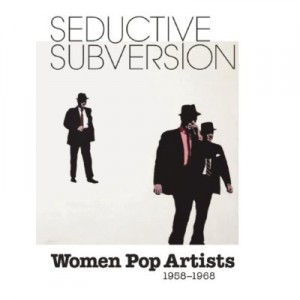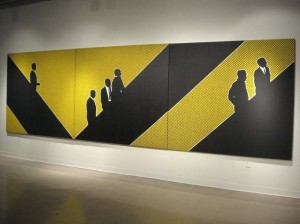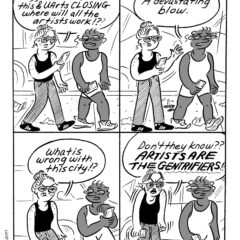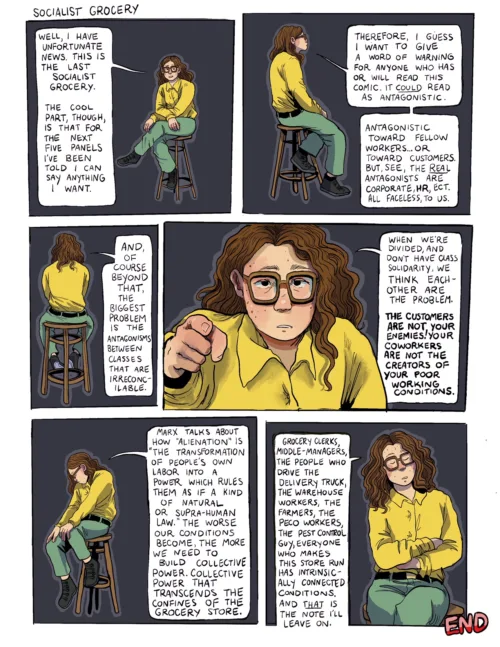Sid Sachs has been writing artists into the art history record for as long as we’ve known him. Tom Nozkowski (at least a decade before he got regular and deserved coverage), Chris Martin, Ree Morton, Rosalyn Drexler– those are a few of the names we knew first through Sachs, who championed them as curator of the UArts gallery, Rosenwald-Wolf.
We don’t know if he’d agree but we think the highpoint of his activist curating, the peak endeavor — on which he toiled for years — is Seductive Subversion: Women Pop Artists 1958-1968, the exhibition and catalog–and the movie. This roundup of the art of long-overlooked women artists from the Pop art era, has been getting acclaim high and low. The show traveled from Philadelphia to the Sheldon Museum of Art in Lincoln, Nebraska, to the Brooklyn Museum and finally to the Tufts University Art Gallery where it will be until April 3. Every step of the way the show has gotten deserved kudos. We’ve written about it here. Ken Johnson in the New York Times weighed in on the Brooklyn Museum iteration. Art in America reviewed it; the Christian Science Monitor reviewed it; ditto the Financial Times. In addition, on March 14 the U.S. section of the International Association of Art Critics (AICA) will award the show first place in the category Best Thematic Museum Shows Nationally. And the show’s beautiful catalog was cited by the New York Times as one of the top art catalogs of the year!
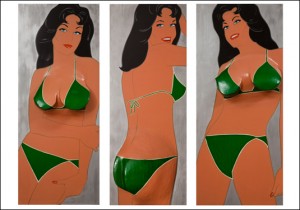
And that’s one of the things we want to tell you about here–the great exhibition catalog, a formidable piece of research and argument by Sachs and Kalliope Minioudaki who co-edited the book and each wrote a fantastic essay. Fleshed out with more essays and personal accounts by some of the women artists and others who were witnesses to the Pop age, the book is not only a good read much of the time, but it’s beautifully designed, generously illustrated, and important as a document that fills in many gaping holes in the historical record.

Is it possible for a catalog essay to be a bodice ripper? Oh, we guess that would be an inappropriate designation, given the feminist roots of this show. But honestly, Sid’s essay, Beyond the Surface: Women and Pop Art 1958-1968 is certainly a pulp-fiction kind of page turner–at least as catalog essays go. He paints a sweeping tableau in plain non-art-speak language of a world in which Pop emerged in response to its time and in succession to the macho excesses of Abstract Expressionism.
Amidst a popular culture and an art culture that dismissed women, women artists created a Pop vocabulary of their own. This book
The power of this catalog, this show, and the accompanying full-length DVD, Seductive Subversion, Women Pop Artists by Glen Holsten, is that they not only brings into focus excellent work by women of that era who had 15 minutes of recognition, only to disappear from the culture and its collective memory. It also brings into focus the failure of art historical story telling, which was unable to transcend its misogynist cultural roots and see the forest for the trees. These ladies were all showing art in the 60s. Some of them showed at Leo Castelli Gallery. Some of them had success. The fact that they were left out of the record until now is pitiful.
Beyond resurrection of the art works, the catalog and movie provide moving individual stories–like that of Pauline Boty, who was dismissed for her beauty; or of Patty Mucha, whose then husband Claes Oldenburg took full credit for his soft sculptures, which she both suggested and then sewed. Marisol’s witty Pop sculptures first earned admiration and then rejection as too slight and too female. And like Boty, she too was dismissed for her beauty.
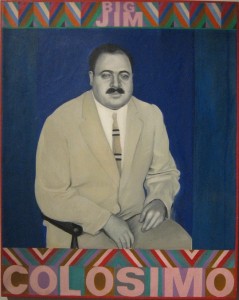
It wasn’t only male critics who did this. Lucy Lippard–one of the biggest feminists of them all — also dismissed the work, according to co-editor Minioudaki. Minioudaki’s essay, although filled with the thorny language of feminist political philosophy, makes a strong case against Lippard and the critical art history boys. The book includes essays by art historians Linda Nochlin, Bradford R. Collins, Annika Ohrner, and Sue Tate. Artist essays are by Martha Rosler and Patty Mucha.
The reproductions of work by 24 overlooked women artists in the catalog on their own create a powerful argument not only for a female presence in Pop but also for a broadening of the male-centric definition of Pop, which virtually excised the women’s vision from the argument.
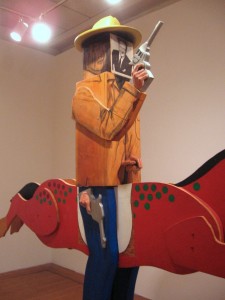
This is a book that belongs in all college libraries. It belongs in your library as well. And the DVD, with its montage of footage from the Pop era and interviews with some of the artists now broadens and humanizes the discussion. That it’s taken the women of pop 50 years to get into the record is sad. But Sid Sachs’ curatorial activism, which made it possible, is a championship story of pluck and determination in the face of nay-saying and roadblocks. Give this guy a MacArthur award please, right now.
Read the reviews:
Edward Sozanski in the Philadelphia Inquirer
Shannon Smith in the Daily Nebraskan
Ariella Budick in the Financial Times
Anne Wehr in Time Out New York
Carol Strickland in the Christian Science Monitor
about the catalog
Tom Capelongs in Art Museum Journal
Ken Johnson in NY Times holiday art book guide
#9 on the NY Times 2010 Gift Guide for Art Books
How to purchase
On Amazon:
Seductive Subversion: Women Pop Artists 1858-1968
Sid Sachs and Kalliopi Minioudaki, Co-Editors
University of the Arts, Philadelphia
Abbeville Press Publishers, New York and London
Cloth, 248 pages
127 Illustrations, 92 in full-color
Published 2010
ISBN: 978-0-7892-1065-4
Or contact University of the Arts to purchase a catalog and the DVD:
Rosenwald-Wolf Gallery
The University of the Arts
333 South Broad Street
Philadelphia, PA 19102
215-717-6480
ssachs@uarts.edu


